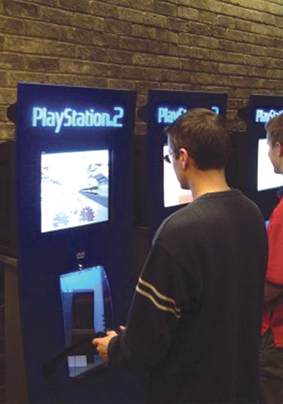|
|
:
Computer Games |
|
|
|||||||||||||
| Questions/instructions: |
|||||||||||||
| %
responses |
|||||||||||||
| y4
|
y8 |
||||||||||||
| 1. How many of you have played computer games? | |||||||||||||
| not
marked |
• |
• |
|||||||||||
| Hand
out picture. |
|||||||||||||
| Here
is a picture of someone playing a computer game. Some people think it is good for children to play computer games. Others think it is not good for children to play computer games. In this activity, you will be discussing the good and not so good things about computer games. As you discuss your ideas, write them on this sheet so that we can talk about them later. |
|||||||||||||
| Hand out answer sheet. Allow time. | |||||||||||||
| 2. Tell me the good and not so good things about children playing computer games. | |||||||||||||
| Good things: | |||||||||||||
develops
useful skills (problem solving, hand/eye coordination) |
8
|
28 |
|||||||||||
gives
useful knowledge |
66
|
62 |
|||||||||||
positive
social reasons (play with someone) |
6
|
18 |
|||||||||||
motivating/entertaining/enjoyable
|
61
|
73 |
|||||||||||
| Not so good things: | |||||||||||||
negative
social reasons (do by yourself) |
32
|
68 |
|||||||||||
health
issues (eye strain, RSI, lack of exercise) |
81 |
75 |
|||||||||||
learning
undesirable skills/knowledge/ attitudes (violence) |
39
|
55 |
|||||||||||
| Students respond. | |||||||||||||
| 3. Are there any ideas you want to change or more ideas that you want to add to your answer sheet? | |||||||||||||
| Allow time for students to change or add ideas. | |||||||||||||
| Computer games change as inventors think of new ideas. In your group discuss how you would like computer games to be improved in the future. Write down your answers on the back of the sheet of paper. It would be good if a different person was your writer this time. | |||||||||||||
| Turn the answer sheet over and encourage a different student to scribe for this part of the task. Allow time. | |||||||||||||
| 4. Tell me the ideas that you had for improving computer games in the future. | |||||||||||||
| Improving games: | |||||||||||||
greater
impact, realism, use of 3D |
33
|
66 |
|||||||||||
better
designed for social interaction |
8 |
4 |
|||||||||||
more
interactive or able to be customised |
20
|
22 |
|||||||||||
more
educational, knowledge focused |
29
|
25 |
|||||||||||
ideas
for reducing health concerns |
3 |
5 |
|||||||||||
| Students respond. | |||||||||||||
| 5. Are there any ideas you want to change or more ideas that you want to add? | |||||||||||||
| Allow time for students to change or add ideas. | |||||||||||||
Total
score (based on questions 2 and 3): 6–7
|
1 |
6 |
|||||||||||
5
|
5 |
21 |
|||||||||||
4
|
21 |
35 |
|||||||||||
3
|
40
|
22 |
|||||||||||
2
|
26
|
13 |
|||||||||||
0–1
|
7 |
3 |
|||||||||||
| Commentary: Year 8 students generally identified more good and not so good aspects than year 4 students, with 35 percent more identifying four or more aspects. |
|||||||||||||
